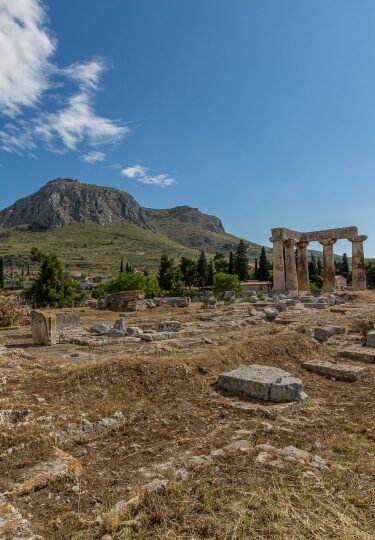Athens, Europe’s oldest capital city, boasts some of the world’s most extraordinary antiquities, ancient ruins, and fascinating museums. But if you’ve visited the capital of Greece before, it might be time to explore some of the best day trips from Athens.
With most visitors to Greece heading either for the islands—such as Mykonos, Santorini, Crete, and Rhodes—or the Acropolis of Athens, there are many worthwhile day trips from the capital that offer an exciting alternative to Greece’s more obvious attractions. The good news is that many of the country’s best landmarks can easily be reached by car, bus, or ferry from Athens in a day.
From shimmering lakes to ornate monasteries, make the most of your next Eastern Mediterranean vacation with one of these 10 unforgettable day trips from Athens, Greece.
Temple of Poseidon
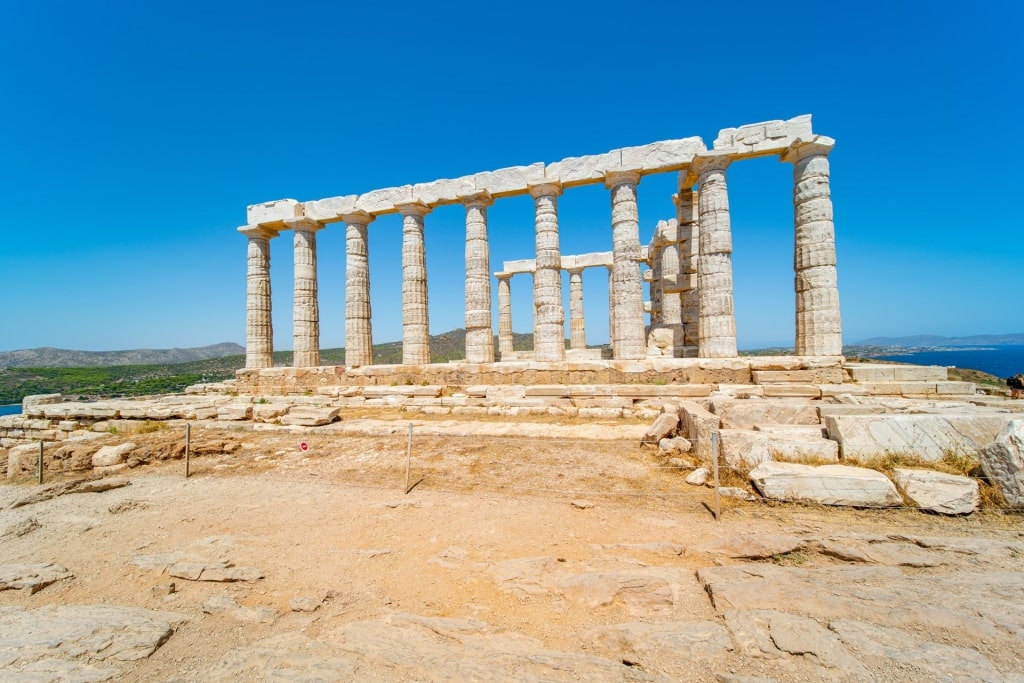
Temple of Poseidon
If you’ve already visited the Parthenon in Athens, consider a day trip to the Temple of Poseidon. One of the most significant remains of the Golden Age of Athens—the period between 449 and 431 B.C.—the elegant Temple of Poseidon perches on top of Cape Sounion, on the southernmost tip of Attica.
The white marble temple is part of the open-air Archaeological Site of Sounion. It features graceful Doric columns that glint in the sunlight, chiseled on the clifftop some 43 miles south of Athens. Look out for the Saronic Islands, lying off the coast, on the journey from Athens to Sounion. The sea views are among the most bewitching in all of Greece and the sunsets here are legendary.
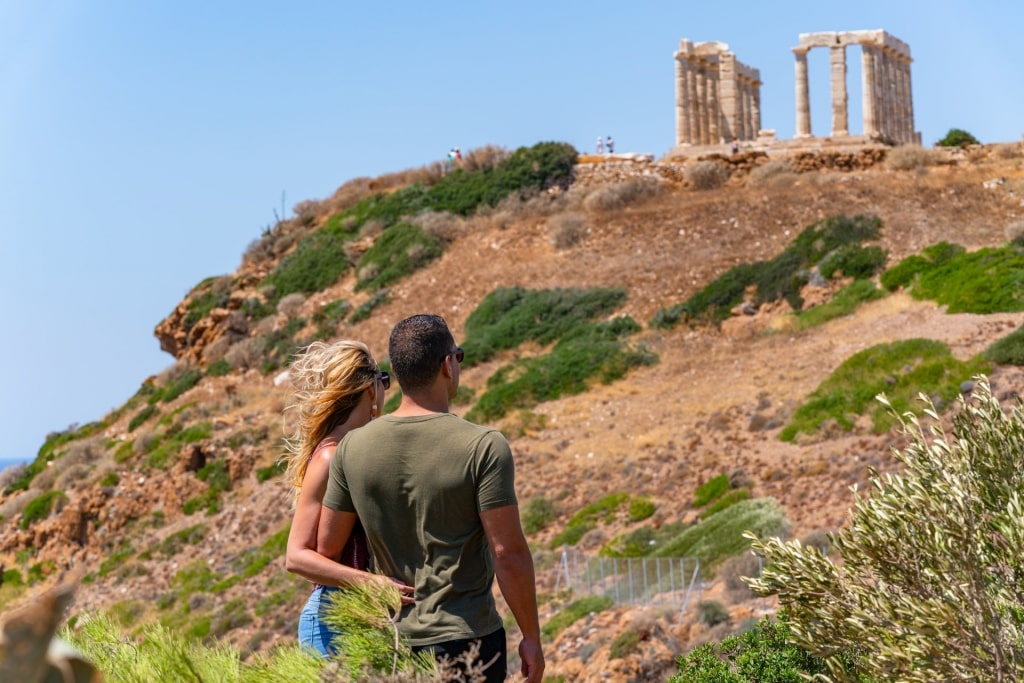
Temple of Poseidon
According to ancient Greek religion, Poseidon was one of the twelve Olympians, known as the God of the Sea, so it is only fitting that he had a gleaming temple built in his honor, overlooking the sparkling waters of the Aegean Sea.
The temple plays a role in mythology, too. According to legend, it was here that King Aegeus, waiting for his son Theseus to return from Crete after doing battle with the Minotaur, flung himself off the cliff in despair.
Theseus had in fact slaughtered the half-man, half-bull monster but had forgotten to replace the black sails of his ship with the white sails of victory. When Aegeus saw the black sails, he assumed, mistakenly, that his son had died. His name was subsequently given to the sea, the Aegean.
Once you’ve explored the site, including the Temple of Athena Sounias, the museum, and the gift store, relax on the golden sands of Souniou Beach. Lying below the Temple of Poseidon, the beach offers the chance to cool off with a dip in the delicious cyan-blue sea.
Read: Three Days in Athens
Mount Parnitha National Park
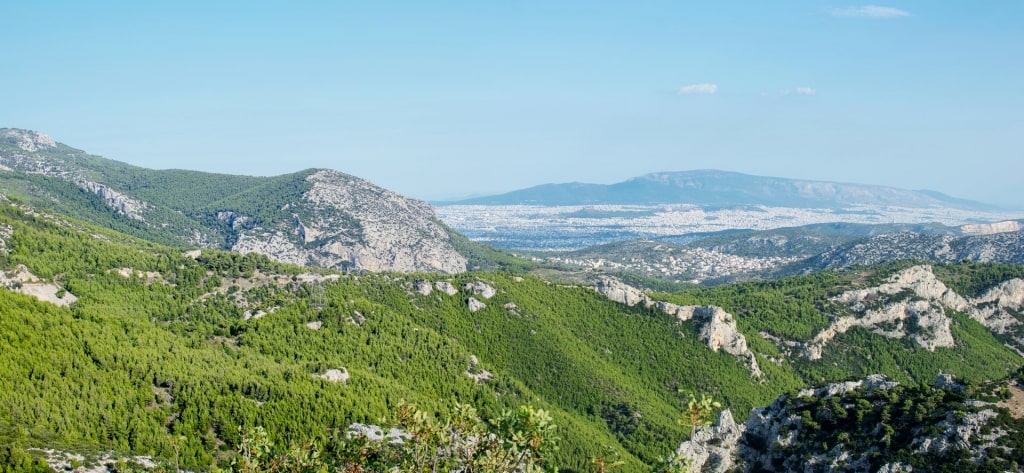
Mount Parnitha National Park
A one-hour drive north from the capital will lead you to Mount Parnitha National Park, one of the best day trips from Athens. Central to the park is the Parnitha mountain range, peaking at 4,635 feet.
The dramatic national park is home to deep gorges, streams, dense woodlands, and an abundance of wildlife. Wild animals in Mount Parnitha National Park include many red deer and an array of bats, reptiles, and birds. You could visit the Voutima Refuge within the park to see, and learn about, the local wildlife.
Hiking is one of the most popular activities in the mountain range. Here, you’ll find some of the best hiking in Greece. Lace up your boots and head off with a guidebook and a map to follow one of the signposted routes. There are many hiking options of varying altitudes and lengths. Look out for the red signs on rocks, trees, and signposts. Layer up as the higher you climb, the chillier it can feel.

Mount Parnitha National Park
Stroll through fragrant fir and Aleppo pine forests. You might also encounter wildflower meadows, but remember to stick to dedicated paths to help protect the native flora. Other activities include climbing, mountain biking, and wildlife photography.
Several monasteries and chapels are dotted around the foothills of the national park. Look out for the 17th-century Koimisi Theotokou Kleiston monastery—once a sanctuary for monks, it’s now occupied by nuns—located south-southwest of Parnitha, near the village of Fyli.
Corinth Canal
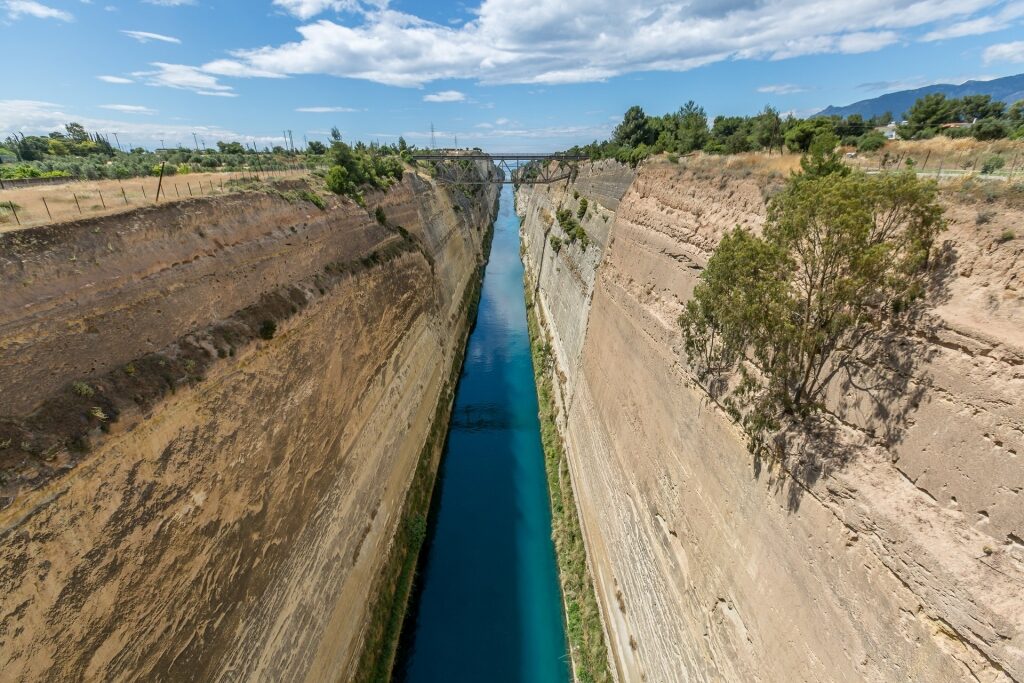
Corinth Canal
Cutting through the narrow Isthmus of Corinth, the Corinth Canal is one of the most famous man-made waterways on the planet and makes for an unforgettable day trip from Athens.
Upon completion in 1893, this manufactured four-mile canal created a new trade route to connect the Ionian and Aegean seas. Today, the Corinth Canal is more of a tourist attraction than a practical commercial route since most modern-day ships are too large to pass through the skinny channel.
Marvel at the remarkable engineering work undertaken to create the Corinth Canal, with the walls soaring 230 feet above the sapphire water, which beautifully contrasts with the limestone rockface.
Peer over one of the footbridges to watch small cruise ships and other vessels squeeze through the 75-foot-wide canal. Or join a leisurely cruise to glide through the Corinth Canal and get a sense of its narrowness.
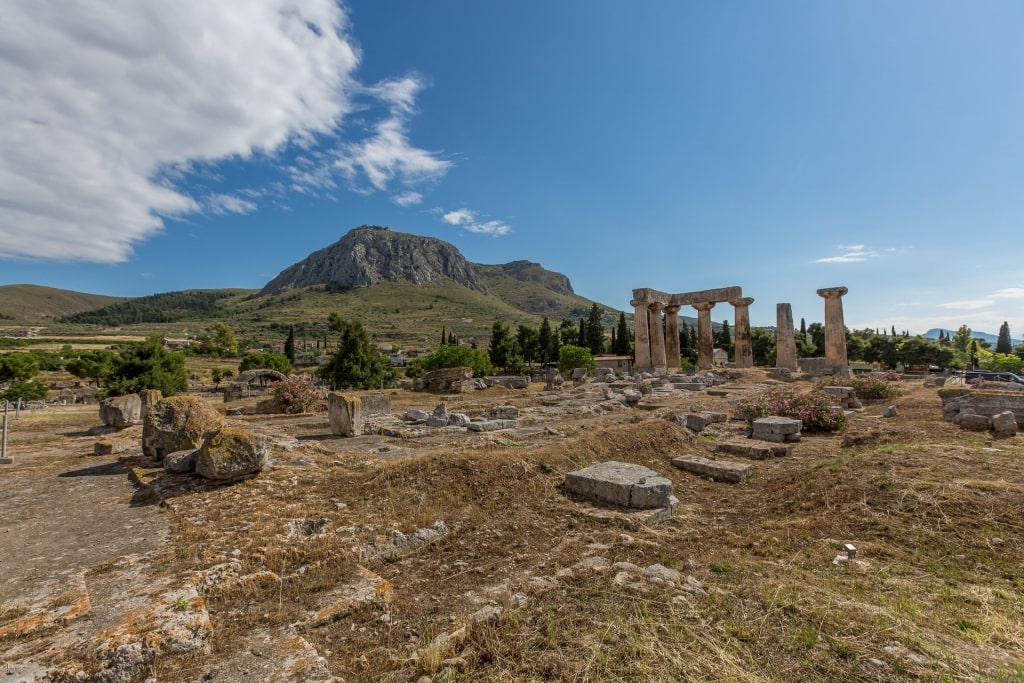
Corinth
Tag on a visit to Ancient Corinth, a short drive from the canal, to explore the fascinating Archaeological Museum and the gleaming Temple of Apollo, with its seven remaining columns.
The Monastery of Daphni
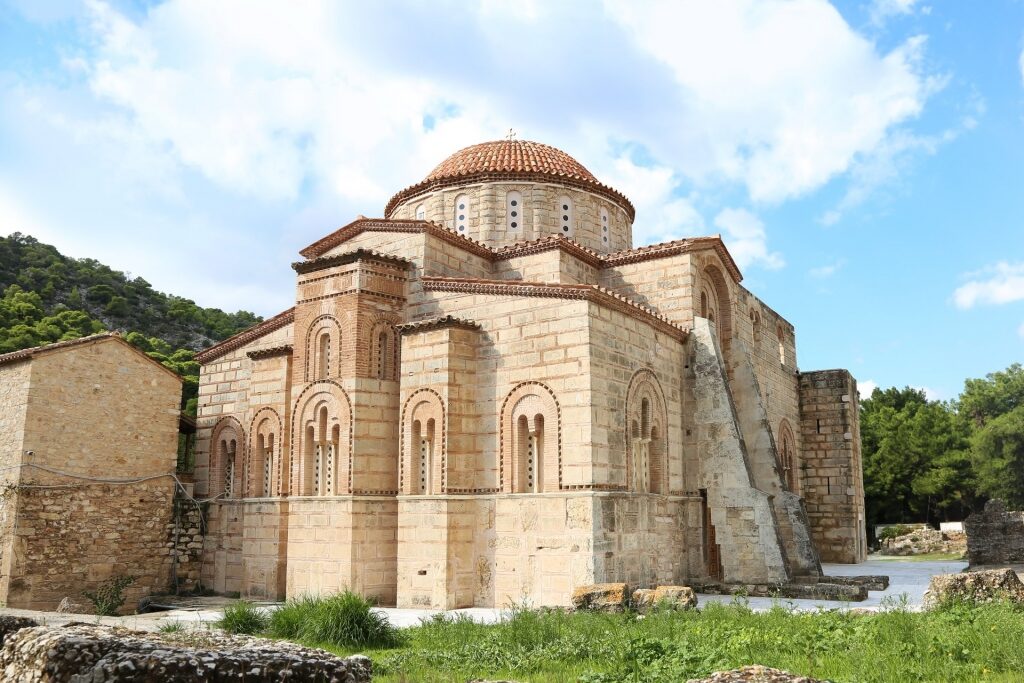
The Monastery of Daphni
Just a 20-minute ride northwest of Athens, in the suburb of Chaidari, lies the 11th century Byzantine Monastery of Daphni. Along with the monasteries of Hosios Loukas and Nea Moni of Chios, the Monastery of Daphni was awarded UNESCO status in 1990, primarily because of its detailed mosaics on a gold background.
The Monastery of Daphni features a large dome over a central octagonal space, with a square bay off each side. Despite the monastery sustaining damage during the 1999 magnitude 6.0. earthquake—with the epicenter occurring near Mount Parnitha—authorities quickly restored the building.
Visit today, and you’ll get to witness the monastery’s original architecture and decorative elements, including religious wall mosaics and ornate marble.
Nafplio
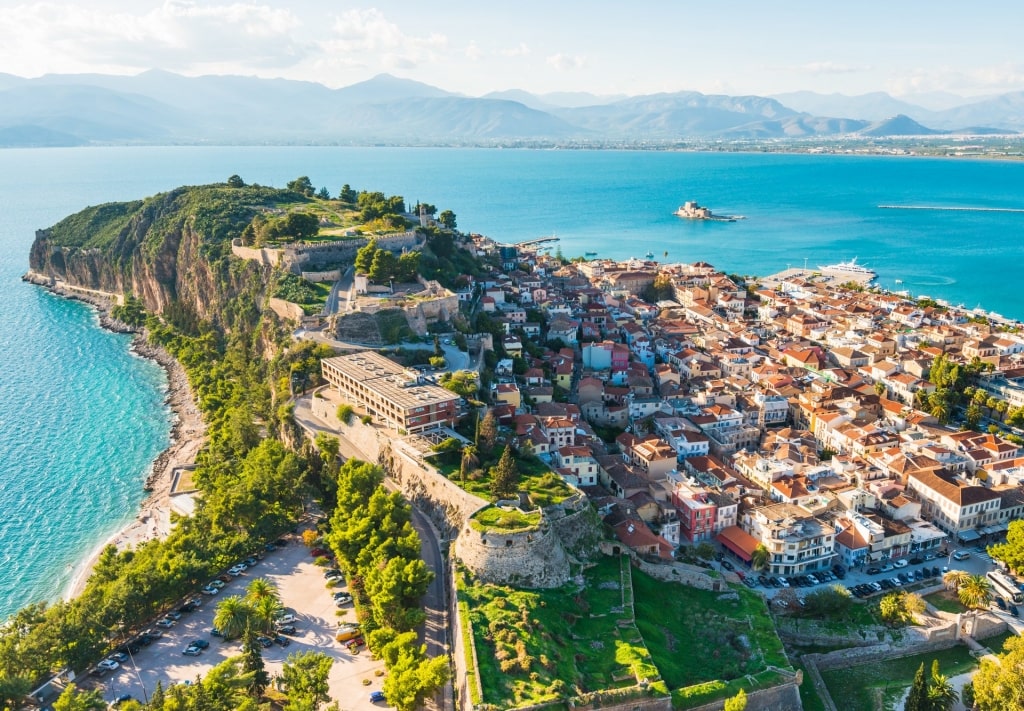
Nafplio
Culture-packed Nafplio is a former capital of Greece that makes for an idyllic day trip from Athens. Stop to take photos of the Corinth Canal, which you’ll cross at roughly the halfway mark of the two-hour journey, before continuing to this handsome Peloponnese port town.
When you arrive, take a boat trip to the 15th-century Bourtzi Castle, which rests on an island in the harbor. The standout attraction in Nafplio is arguably Palamidi Fortress, built in the early 19th century by the Venetians, peering over the town from a 700-foot hilltop.
Explore the fortress’ eight bastions, the central one containing the chapel of Saint Andrew. Views from the top, overlooking the bay, are priceless.
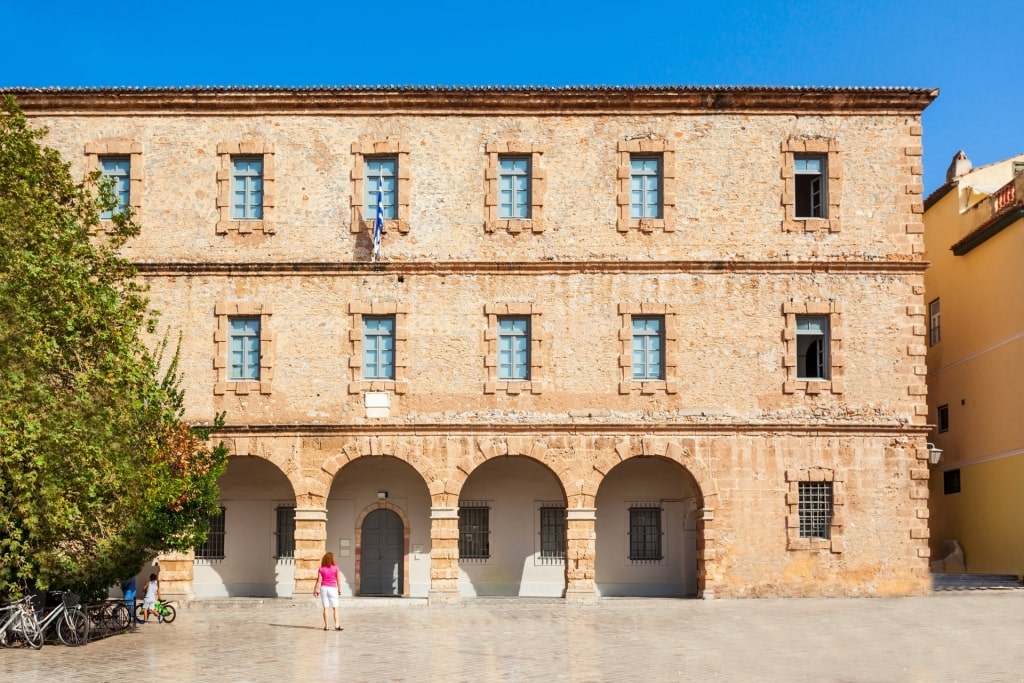
Archaeological Museum of Nafplio
Browse the Archaeological Museum of Nafplio, housed inside a beautiful Venetian building located on the elegant Syntagma Square. Afterward, take a seat anywhere off Leoforos Vasilisis Amalias to enjoy some of the region’s famous hospitality. This area has some superb back-street tavernas.
Much like shopping in Athens, the markets in Nafplio are excellent, too. Pick up handmade leather sandals, local honey, or the region’s famous amber worry beads, known as komboloi. There’s even a Komboloi Museum in Nafplio, which reveals the history of these colorful accessories used as a relaxation tool and to guard against bad luck.
Mycenae
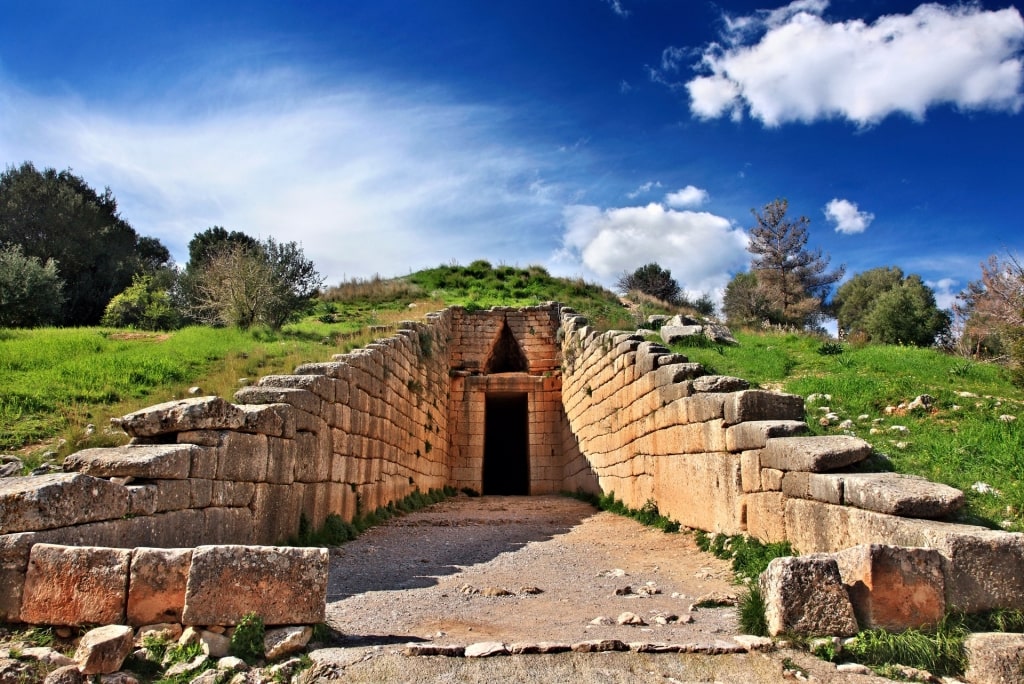
Mycenae
The Bronze Age site of Mycenae is another treasure of the Peloponnese peninsula. This ancient citadel, now surrounded by verdant Mediterranean scrub, was one of the most significant centers of the Mycenaean civilization.
Homer famously based “Iliad” and “Odyssey”—considered two of the most influential works of ancient Greek literature—on Mycenae, as the kingdom of the mythical King Agamemnon. For centuries, archeologists have been fascinated by Mycenae, with essential finds corroborating Homer’s descriptive literature on the fortified site.
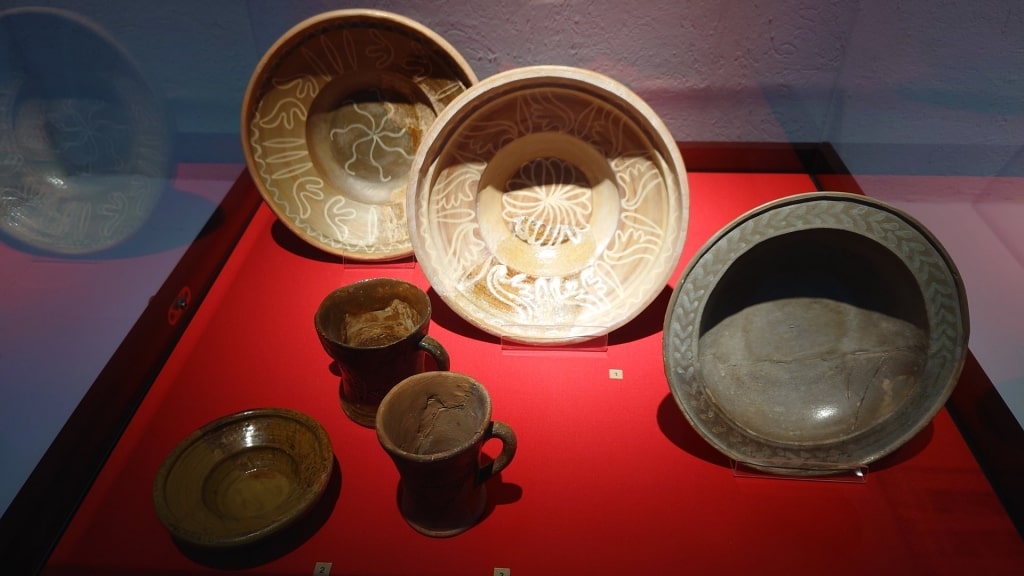
Archaeological Museum of Mycenae
Start your visit by exploring the Archaeological Museum of Mycenae to learn about the ruins and the significance of the 19th-century excavations led by Heinrich Schliemann. This UNESCO World Heritage Site once contained royal apartments, bathing facilities, and corridors decorated with colorful frescoes that exuded wealth.
Explore the Greek ruins, including the main gate with its decorative lions, and the famous Beehive Tomb, which is said to be the resting place of King Agamemnon.
Epidaurus
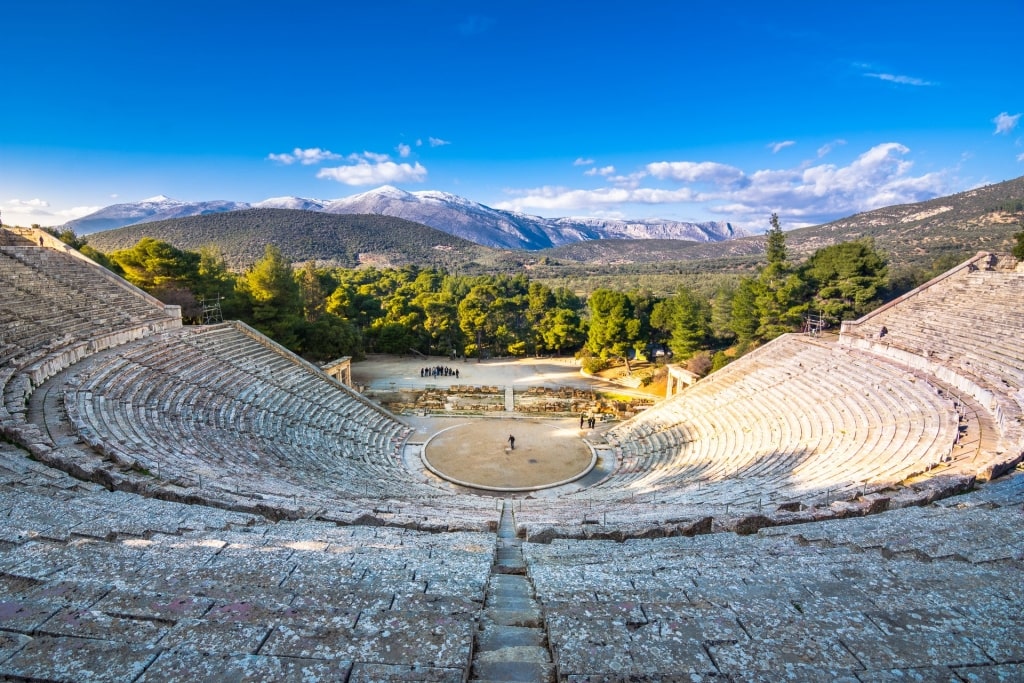
Epidaurus
Lying in the northeast of the Peloponnese, Epidaurus is an ancient city surrounded by green olive groves and leafy vineyards. Designed by Polykleitos the Younger in the 3rd century BC, Epidaurus’ limestone amphitheater once seated up to 12,000 spectators, making a grand statement with its near-perfect symmetry and excellent acoustics.
Explore the ruins of the Temple of Asclepius, a revered healing and bathing center during ancient times. The Archaeological Museum of the Asclepieion of Epidaurus exhibits artifacts excavated from the site following its discovery in the late 19th century.
Look out for the annual arts festival that takes place between May and October across several theaters in Greece, including Epidaurus. The festival program includes performing arts, music, and other cultural events.
Lake Marathon
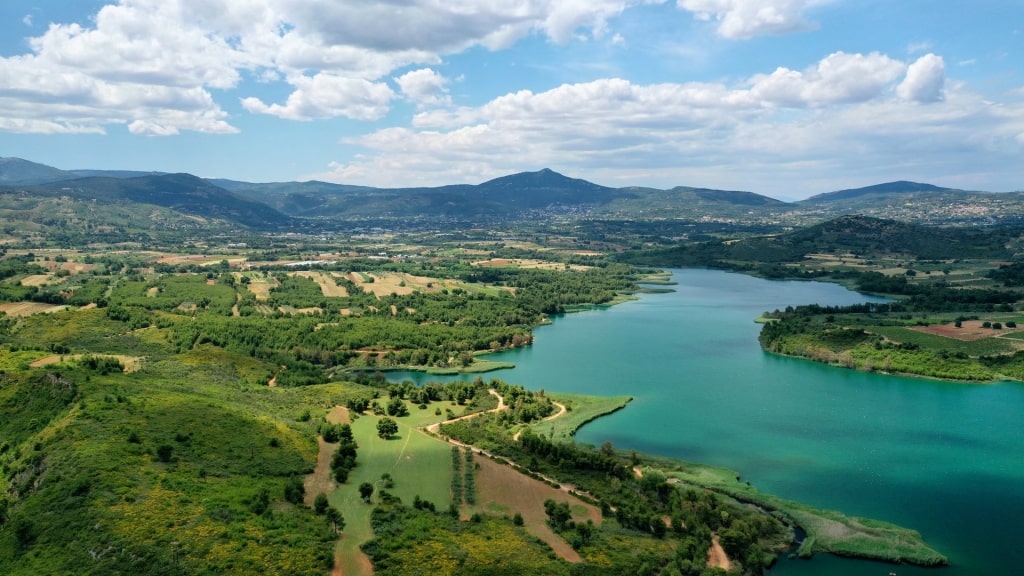
Lake Marathon
The artificial Lake Marathon is a beautiful patch of water featuring a 177-foot-high, white-marble dam, 28 miles north of Athens. The lake is surrounded by lush vineyards and orange groves that contrast beautifully with the shimmering blue water. A parking lot at the dam provides spectacular views of the lake and the bucolic countryside that surrounds it.
Nearby attractions include the Archaeological Museum of Marathon and the Marathon Run Museum. It’s easy to remember the distance from the compact town of Marathon to Athens.
It’s just over 26 miles, which was the distance of the first marathon to take place at the 1896 Olympics, the first modern games, held in Athens. Olympic torches, medals, original posters, and photos are among the items on display at the Marathon Run Museum.
Read: 22 Best Lakes in Europe
Nemea
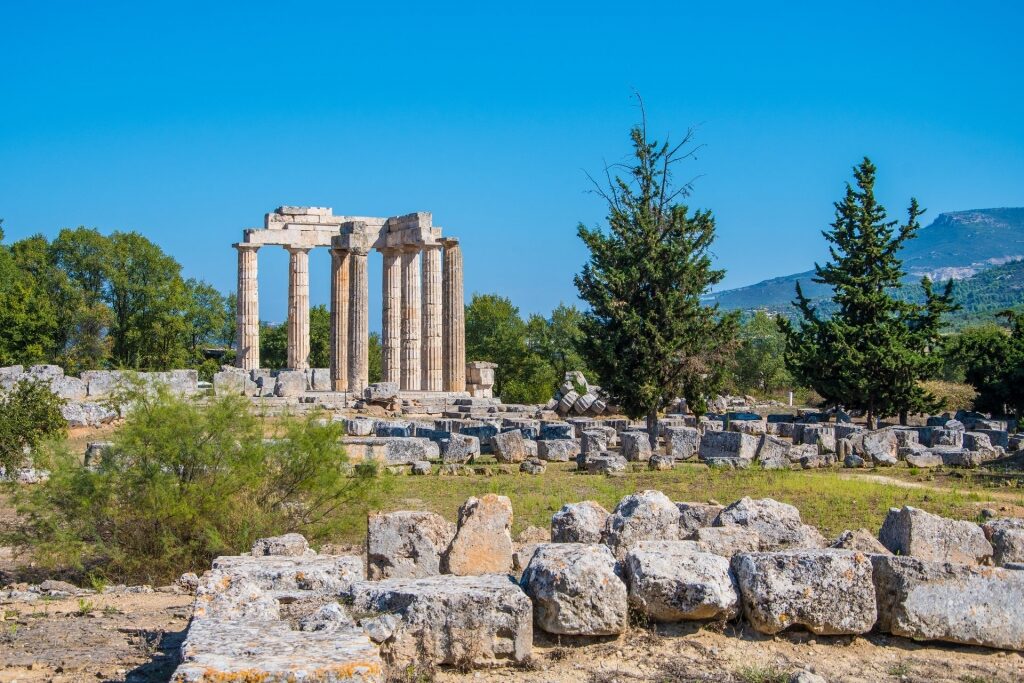
Nemea
If you’re in the mood for ancient temples and imbibing on some lip-smacking wines, Nemea is one of the best day trips from Athens. In Greek mythology, Nemea is recognized as the home of the Nemean Lion, killed by Heracles as the first of his 12 labors.
The Nemean Games—one of the four locations of ancient Greece’s Panhellenic Games—were held at the Temple of Zeus at Nemea. Tour the sanctuary’s honey-colored Doric columns and the old athletics stadium.
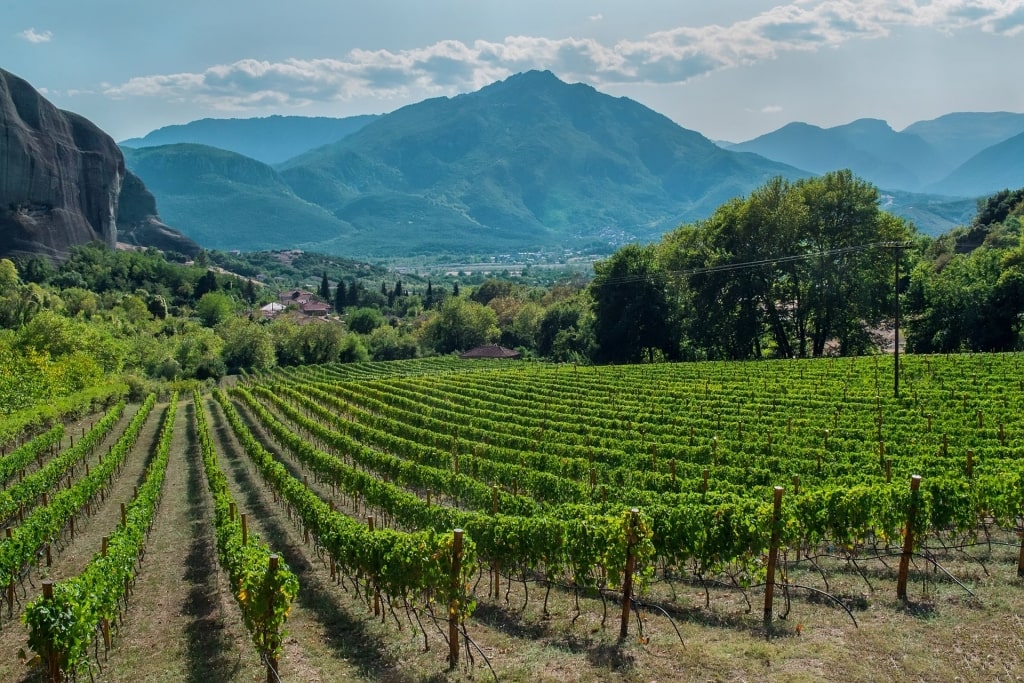
Nemea
Afterward, make your way to some of the area’s best wineries, with notable Peloponnese vineyards including Lantides, Barafaka, Mitrakos, Raptis, and the Semeli Estate. Few experiences beat savoring a chilled glass of wine in the sunshine while gazing out at the very same vines on which the grapes were grown.
Before sampling some of the delicious wines produced in Nemea, learn about the grapes and the history of viticulture in this sun-drenched region on a winery tour.
Aegina
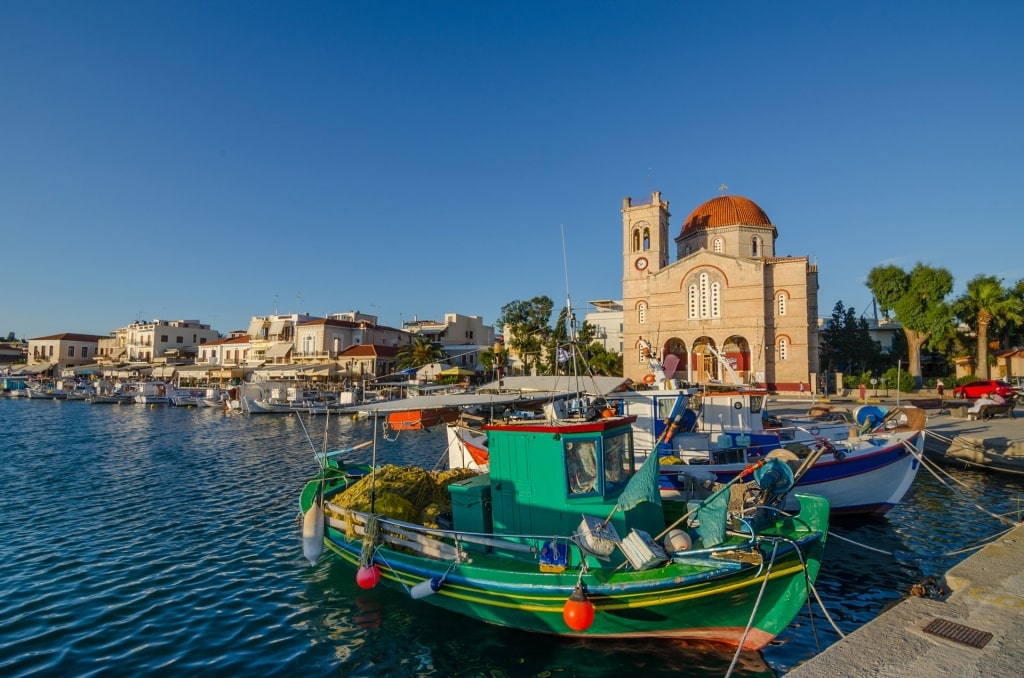
Aegina
If you want to experience Greek island life on a day trip from Athens, take a ferry from Piraeus to Aegina, the largest Saronic island. There’s a regular ferry service and the high-speed journey takes approximately 40 minutes, while some more extended services take up to one hour 15 minutes each way.
Surrounded by topaz waters, relaxed Aegina feels like a world away from the bustling streets of Athens. Sugary-sand beaches and thick pine forests are interspersed with ancient ruins, charming marinas, and laidback tavernas.
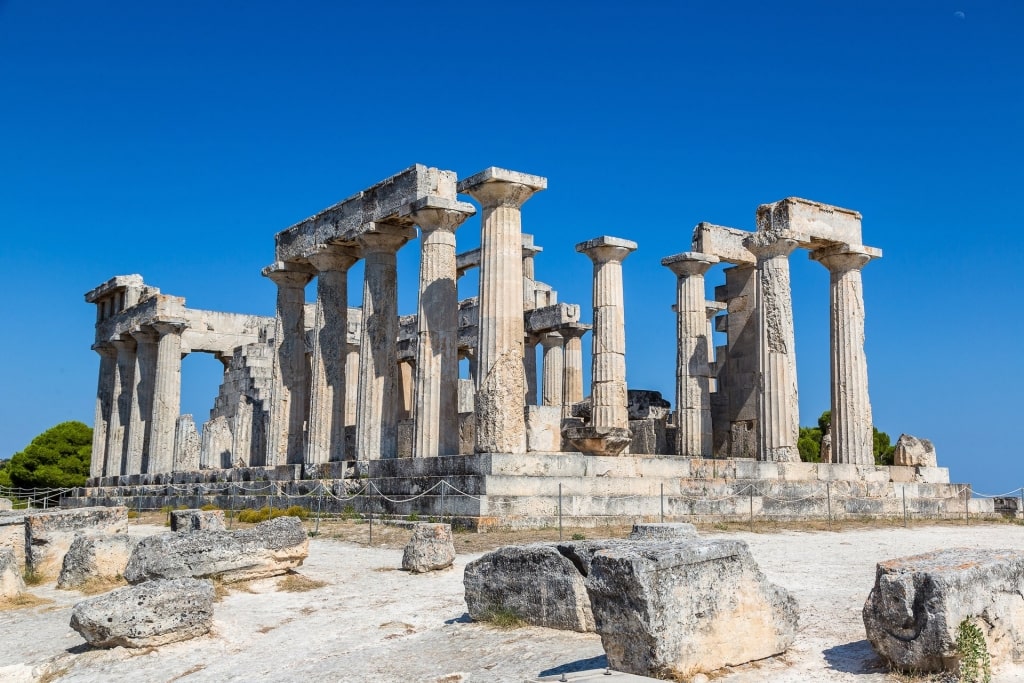
Temple of Aphaia, Aegina
Hop off the ferry in the capital, Aegina, and wander the picturesque waterfront and back streets. Pick up a bag of plump pistachios from a local store to snack on; the sweet-tasting nuts are grown on the island, along with olives, almonds, and figs.
Marvel at Aegina’s neoclassical buildings and the island’s largest church, Isodia Theotokou, flanked by palm trees. In the northeast of Aegina, head to the Temple of Aphaia, built in 480 BC and dedicated to the ancient goddess Aphaia, overlooking the Saronic Gulf.
There are plenty of lovely beaches to choose from in Aegina. Go off-the-beaten-path on Klima Beach, a secluded cove on the island’s south coast.
A short distance west, Perdika Beach is another marvelous option. You’ll find delightful tavernas serving fresh fish lining Perdika’s sleepy marina. Take a seat on an outdoor terrace and enjoy the rhythm of the comings and goings of fishing boats offloading their catch.
Read: Best Beaches in Athens
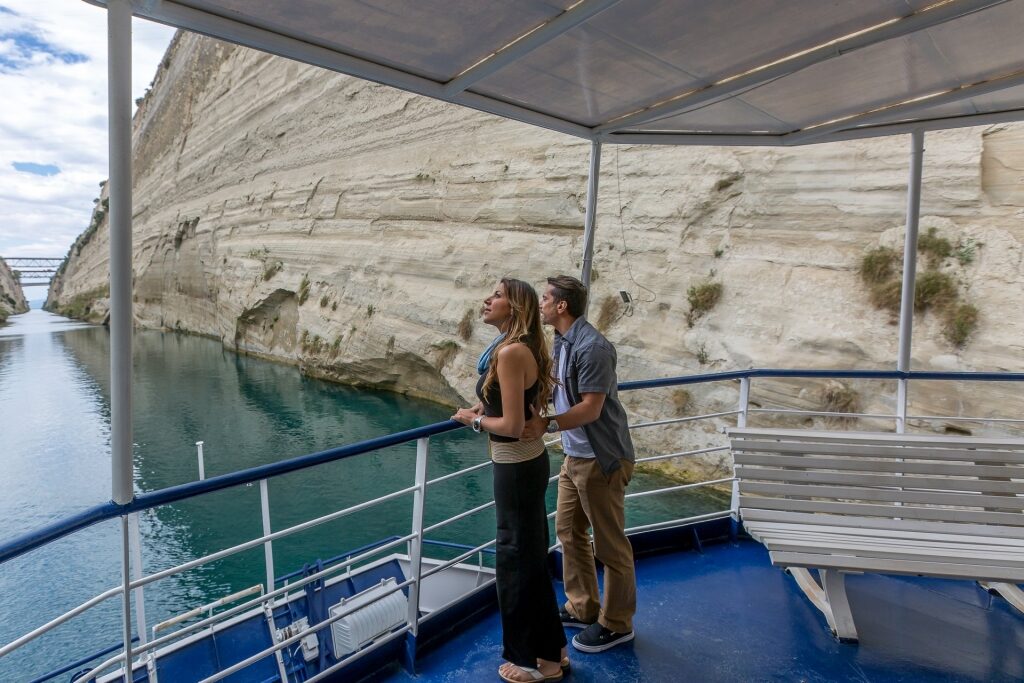
Corinth Canal
If you’re inspired to embark on some of the best day trips from Athens, Greece, it’s time to start planning a cruise for your next eastern Mediterranean vacation. Browse our Greek cruises and discover the country’s enticing beaches, natural wonders, and ancient cities.
